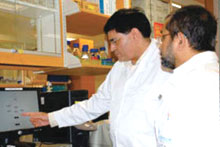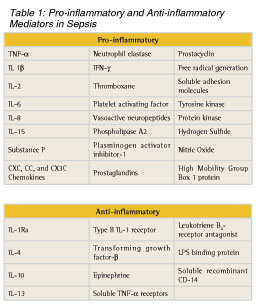|
by Madhav BHATIA and Shabbir MOOCHHALA
 eptic shock is a very serious medical condition caused by decreased tissue perfusion and oxygen delivery as a result of infection and sepsis. It can cause multiple organ failure and death. Sepsis is defined as the presence of bacteria or their toxins in blood or tissue and the systemic response that follows. A systemic inflammatory response syndrome (SIRS) triggered by infection is known as sepsis. Sepsis leading to at least one organ failure characterizes severe sepsis and septic shock is defined by severe sepsis accompanied by hypotension unresponsive to fluid resuscitation. Severe sepsis and septic shock are one of the leading causes of mortality among intensive care unit and post-operational care patients. The incidence of sepsis in North America has been reported to be 3.0 per 1000 population, which transforms into an annual number of 750,000 cases with 210,000 of them being fatal, and a large socio-economic burden. The incidence of mortality due to sepsis is increasing. To date, there is no known cure for sepsis and septic shock and treatment is mostly supportive. eptic shock is a very serious medical condition caused by decreased tissue perfusion and oxygen delivery as a result of infection and sepsis. It can cause multiple organ failure and death. Sepsis is defined as the presence of bacteria or their toxins in blood or tissue and the systemic response that follows. A systemic inflammatory response syndrome (SIRS) triggered by infection is known as sepsis. Sepsis leading to at least one organ failure characterizes severe sepsis and septic shock is defined by severe sepsis accompanied by hypotension unresponsive to fluid resuscitation. Severe sepsis and septic shock are one of the leading causes of mortality among intensive care unit and post-operational care patients. The incidence of sepsis in North America has been reported to be 3.0 per 1000 population, which transforms into an annual number of 750,000 cases with 210,000 of them being fatal, and a large socio-economic burden. The incidence of mortality due to sepsis is increasing. To date, there is no known cure for sepsis and septic shock and treatment is mostly supportive.
Pro- and Anti-inflammatory Mediators
 Recent work in our laboratories as well as in other laboratories Recent work in our laboratories as well as in other laboratories around the world has shown an important role of different proand anti-inflammatory mediators in sepsis, and has resulted in the identification of several new therapeutic targets for this condition. These mediators are summarized in Table 1, and we shall expand here a little on some of the mediators which our laboratories have been working on. This work has been published in a series of premier and leading international journals (e.g. FASEB J, J Immunol, J Leuk Biol, Br J Pharmacol, Am J Physiol, J Pathol, Shock, etc.). Recent work in our laboratories as well as in other laboratories Recent work in our laboratories as well as in other laboratories around the world has shown an important role of different proand anti-inflammatory mediators in sepsis, and has resulted in the identification of several new therapeutic targets for this condition. These mediators are summarized in Table 1, and we shall expand here a little on some of the mediators which our laboratories have been working on. This work has been published in a series of premier and leading international journals (e.g. FASEB J, J Immunol, J Leuk Biol, Br J Pharmacol, Am J Physiol, J Pathol, Shock, etc.).
The chemokines are small 8 to 10 kDa proteins. Over 40 chemokines have been identified to date. The chemokine receptor CCR1 is expressed by a broad spectrum of leukocytes, including neutrophils, monocytes, eosinophils, and lymphocytes. CCR1 has three main ligands in vivo CCL3 (MIP1-a), CCL5 (RANTES), and CCL6 (chemokine C10). In a recent study, we have shown that treatment with BX471, a CC chemokine receptor 1 antagonist, attenuates systemic inflammatory response during sepsis. Furthermore, administration of exogenous fractalkine, a CX3C chemokine, is capable of modulating inflammatory response in cecal ligation and puncture-induced sepsis.
 Substance P is an 11-amino acid neuropeptide that is released from nerve endings in many tissues. It acts via membrane bound NK1 receptors (NK1R) and in addition to being a mediator of pain, has been shown to play an important role in some, but not all inflammatory states. Using experimental models of cecal ligation and puncture-induced sepsis as well as lipopolysacchrideinduced endotoxemia, we have shown a pro-inflammatory role of substance P in sepsis. In a follow-up study, we were able to show that treatment with an NK1R antagonist resulted in protection against sepsis. Substance P is an 11-amino acid neuropeptide that is released from nerve endings in many tissues. It acts via membrane bound NK1 receptors (NK1R) and in addition to being a mediator of pain, has been shown to play an important role in some, but not all inflammatory states. Using experimental models of cecal ligation and puncture-induced sepsis as well as lipopolysacchrideinduced endotoxemia, we have shown a pro-inflammatory role of substance P in sepsis. In a follow-up study, we were able to show that treatment with an NK1R antagonist resulted in protection against sepsis.
Hydrogen sulfide (H2S) is well-known for several decades as a toxic gas with the smell of rotten egg. Here at NUS, we have shown for the first time a role of endogenously produced H2S as a mediator of inflammation in several conditions, such as acute pancreatitis, joint inflammation, and sepsis. In studies published in several high impact journals in the last couple of years, we have shown that H2S acts via interactions with substance P, chemokines, and adhesion molecules (thereby affecting leukocyte recruitment that contributes to organ dysfunction), and that inhibition of H2S synthesis could be a potential therapeutic approach for the treatment of sepsis.
In summary, recent studies have shown that there has been substantial progress in the understanding of the role of inflammatory pathways in the pathogenesis of sepsis. The ultimate severity of the disease greatly depends on the interplay between pro- and anti-inflammatory mediators. We hope the clinical trials of new anti-inflammatory pharmacological strategies would reduce the morbidity and mortality in this common, and as yet incurable, clinical condition.
 Click here to download the full issue for USD 6.50 Click here to download the full issue for USD 6.50
|


 eptic shock is a very serious medical condition caused by decreased tissue perfusion and oxygen delivery as a result of infection and sepsis. It can cause multiple organ failure and death. Sepsis is defined as the presence of bacteria or their toxins in blood or tissue and the systemic response that follows. A systemic inflammatory response syndrome (SIRS) triggered by infection is known as sepsis. Sepsis leading to at least one organ failure characterizes severe sepsis and septic shock is defined by severe sepsis accompanied by hypotension unresponsive to fluid resuscitation. Severe sepsis and septic shock are one of the leading causes of mortality among intensive care unit and post-operational care patients. The incidence of sepsis in North America has been reported to be 3.0 per 1000 population, which transforms into an annual number of 750,000 cases with 210,000 of them being fatal, and a large socio-economic burden. The incidence of mortality due to sepsis is increasing. To date, there is no known cure for sepsis and septic shock and treatment is mostly supportive.
eptic shock is a very serious medical condition caused by decreased tissue perfusion and oxygen delivery as a result of infection and sepsis. It can cause multiple organ failure and death. Sepsis is defined as the presence of bacteria or their toxins in blood or tissue and the systemic response that follows. A systemic inflammatory response syndrome (SIRS) triggered by infection is known as sepsis. Sepsis leading to at least one organ failure characterizes severe sepsis and septic shock is defined by severe sepsis accompanied by hypotension unresponsive to fluid resuscitation. Severe sepsis and septic shock are one of the leading causes of mortality among intensive care unit and post-operational care patients. The incidence of sepsis in North America has been reported to be 3.0 per 1000 population, which transforms into an annual number of 750,000 cases with 210,000 of them being fatal, and a large socio-economic burden. The incidence of mortality due to sepsis is increasing. To date, there is no known cure for sepsis and septic shock and treatment is mostly supportive.
 Recent work in our laboratories as well as in other laboratories Recent work in our laboratories as well as in other laboratories around the world has shown an important role of different proand anti-inflammatory mediators in sepsis, and has resulted in the identification of several new therapeutic targets for this condition. These mediators are summarized in Table 1, and we shall expand here a little on some of the mediators which our laboratories have been working on. This work has been published in a series of premier and leading international journals (e.g. FASEB J, J Immunol, J Leuk Biol, Br J Pharmacol, Am J Physiol, J Pathol, Shock, etc.).
Recent work in our laboratories as well as in other laboratories Recent work in our laboratories as well as in other laboratories around the world has shown an important role of different proand anti-inflammatory mediators in sepsis, and has resulted in the identification of several new therapeutic targets for this condition. These mediators are summarized in Table 1, and we shall expand here a little on some of the mediators which our laboratories have been working on. This work has been published in a series of premier and leading international journals (e.g. FASEB J, J Immunol, J Leuk Biol, Br J Pharmacol, Am J Physiol, J Pathol, Shock, etc.).
 Substance P is an 11-amino acid neuropeptide that is released from nerve endings in many tissues. It acts via membrane bound NK1 receptors (NK1R) and in addition to being a mediator of pain, has been shown to play an important role in some, but not all inflammatory states. Using experimental models of cecal ligation and puncture-induced sepsis as well as lipopolysacchrideinduced endotoxemia, we have shown a pro-inflammatory role of substance P in sepsis. In a follow-up study, we were able to show that treatment with an NK1R antagonist resulted in protection against sepsis.
Substance P is an 11-amino acid neuropeptide that is released from nerve endings in many tissues. It acts via membrane bound NK1 receptors (NK1R) and in addition to being a mediator of pain, has been shown to play an important role in some, but not all inflammatory states. Using experimental models of cecal ligation and puncture-induced sepsis as well as lipopolysacchrideinduced endotoxemia, we have shown a pro-inflammatory role of substance P in sepsis. In a follow-up study, we were able to show that treatment with an NK1R antagonist resulted in protection against sepsis.
 Click here to download the full issue for USD 6.50
Click here to download the full issue for USD 6.50